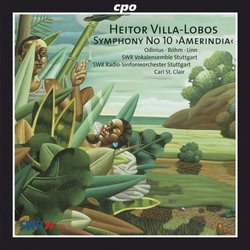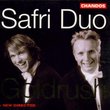| All Artists: H. Villa-Lobos, Staatsopernchor Stuttgart, Carl St. Clair Title: Villa-Lobos: Symphony No. 10 Members Wishing: 0 Total Copies: 0 Label: Cpo Records Original Release Date: 1/1/2008 Re-Release Date: 2/26/2008 Genre: Classical Styles: Historical Periods, Modern, 20th, & 21st Century, Symphonies Number of Discs: 1 SwapaCD Credits: 1 UPC: 761203978625 |
Search - H. Villa-Lobos, Staatsopernchor Stuttgart, Carl St. Clair :: Villa-Lobos: Symphony No. 10
 | H. Villa-Lobos, Staatsopernchor Stuttgart, Carl St. Clair Villa-Lobos: Symphony No. 10 Genre: Classical |
Larger Image |
CD DetailsSimilar CDs
|
CD ReviewsThe Amerindian Symphony Russ | Richmond, VA | 05/04/2008 (4 out of 5 stars) "The twelve symphonies of Villa-Lobos (1887-1959) are grandiose, vivacious and kaleidoscopic. These characteristics draw me to the music of this Braizian master. But at the same time, I often think whether it is these traits that prevent the music from being better known. That is, as I listened to this 74 minute symphony for orchestra, organ and chorus singing Tupi Indian, Portuguese and Latin texts, I could not help but to ask whether this work would have been stronger if the composer had just scaled it back slightly. Less is more, so to speak. That aside, there is a lot to like within Villa-Lobos' 'Amerindian Symphony with Choruses' (Symphony No. 10). Composed in 1952, it was written to commemorate the fourth centenary of São Paolo. The orchestra-only first movement is titled 'The Earth and its Creatures' and is followed by four movements for chorus and orchestra. The program of this symphony is a slightly difficult to describe, but it concerns a dialogue between the 'Voice of the Earth' and a tribe of Indians. The symphony concludes with texts written by José de Anchieta, a Jesuit missionary and one of the founders of São Paolo. As one would expect from this composer, the music is lush and highly contrapuntal. As with other Villa-Lobos symphonies, the movements of this work are constructed through the linking of a series of semi-related segments, rather than sonata form. Or to phrase less technically, it as if the listener is meandering down a musical river, not quite sure what to expect around the next bend. The introductory movement, with its variegated orchestration, aggressive thematic material and climatic conclusion, would be outstanding as a standalone orchestral work. The mysteriously evocative second movement is my personal favorite, with its delicate orchestration, supported by wordless chorus. The lyrical string melody flowing over chirping woodwinds heard here is one of the composer's finest. The scherzo is characteristically frenetic. Lasting more than thirty minutes, the fourth movement (lento) is likely the most problematic of the symphony. There are a lot of interesting textures within this movement, but the melodic material gets lost somewhere. The vigor returns within the symphony's celebratory finale, which contains a series of disparate musical episodes, choral interludes and bird songs capped off by an exhilarating 'Alleluia' coda. All of this is interesting, to say the least. As with the previous issuances in this series, the orchestral playing and sound engineering are great. In conclusion, this is a fascinating, yet uneven, work. Some of the ideas are a bit overextended, but with music of such lushness and vivacity, this can certainly be overlooked. That said, if you have been collecting CPO's Villa-Lobos symphony cycle, this release can be fully recommended. However, if you are new to Villa-Lobos' symphonies, I would start with Villa-Lobos: Symphonies Nos. 6 & 8. TT: 73:30" A good recording of a rarely-heard work David M. Beiler | Chicago, IL, United States | 05/27/2009 (5 out of 5 stars) "If you're new to Villa-Lobos in general, this may not be the symphony for you - it's incredibly grandiose, calling for a huge orchestra, soloists, and a full choir. Depending on your tastes, it very well may be over the top.
That said, if you're a fan of a very histrionic style, this recording is quite good. There are precious few recordings from which to choose, and you won't be going wrong with this one. The soloists are passable, if not to die for; the choir is well-directed and on point; the playing of the orchestra is fine." |








